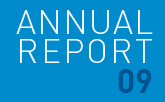As for the evolution of crude oil, in addition to a downturn in most countries it stood out, as it has in recent years, for its volatility. In 2009 this was not as marked as in 2008, although weekly variations of 10% to 15% were typical, indicative of the fact that the crude oil futures market remains attractive for investors of every kind, a feature which jeopardises proper planning of investment in the sector, during a year which saw a clear downturn in investment compared with previous periods.
In the month of June 2008 oil hit a high of almost $150/bbl, followed by a sharp downturn in the last quarter. During 2009 the price remained in the $60-70/bbl range, thereby reducing the volatility of the previous year.
The drop in the demand for energy and the fall in natural gas and crude oil prices were the main reasons behind the downturn in investment in research and prospecting for these raw materials. This circumstance goes hand-in-hand with the increase in exploration costs as a result, for example, of the need to explore deep waters.
The production quota reduction policies agreed by OPEC set the standard followed by other producing countries. However, it was not a year marked by a shortfall of crude oil. On the contrary, the practice of floating tankers waiting for a price rise suggests quite the opposite.
One may only hope that the onset of a widespread and soundly based economic recovery in most countries will not lead to a sudden and dramatic increase in the price of crude, with a knock-on effect on rising prices thereby undermining the continuity of the recovery.
One further significant fact during the year was the solidity of non-conventional gas as an energy source. Previous years had already seen an increase in output of this type of natural gas (in colloquial terms, sand gas, less dense than traditional gas), mainly in the North American market. In 2009 a number of specialists claimed that this was the greatest revolution in the gas world of recent years. The prospect are considerable in other parts of the world also.
After six years of rising coal prices, reaching a peak of $220 per tonne in July 2008, the graph turned downwards in the closing months of the year. In 2009 the price remained around the $70 per tonne level.



